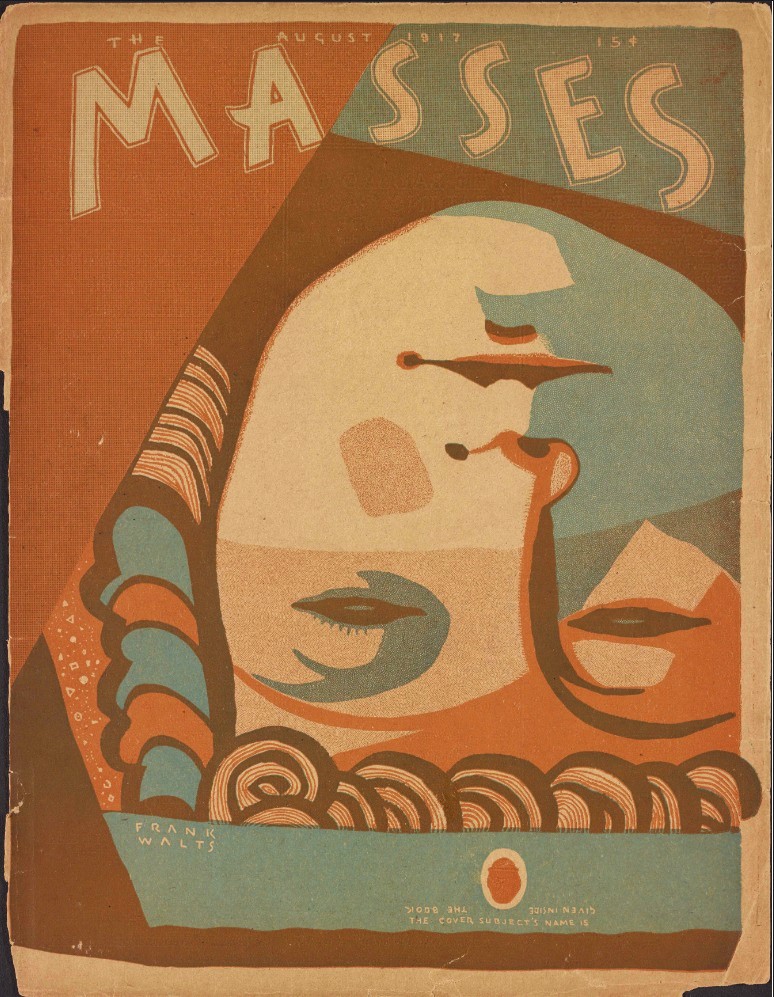The Masses. Vol. 9 No. 10. August, 1917.
Contents: Revolutionary Progress by Max Eastman, Syndicalist-Socialist Russia, It is True, Mobilizing Ideas, A Working Class Peace, Strafe for Democracy! by Howard Brubaker, God Is Love by Irwin Granich, The Bright Side of Getting Licked by John Reed, Militarism at Play by John Reed, Tom Mooney, Dialogue at Sunset by Pierre Louÿs, Poems by Lydia Gibson, The Chances of Peace by Floyd Dell, A Tribute by Josephine Bell, Conscientious Objectors, The Benefactor (Harrison S. Hires, Two Notes by R.S., The People’s Council, Ishmael by Louis Untermeyer, The Bargain by Euphenia Whittridge, The Spirit of Old Russia, The Eagle’s Talons, The Passion of Peeking, and Other Problems by Charles W. Wood, Friends of American Freedom, Books That Are Interesting, Suffrage and Sedition, Knit a Strait-Jacket for Your Soldier Boy, Liberty Loan by Patrick Kearney, Making a Safe by Elizabeth Waddell, Petition to the President and Congress of the United States for the Immediate Repeal of the Present Conscription Law. ART BY Adolph Dehn, J.F. Horrabin, Cornelia Barns, Art Young, Boardman Robinson, Hugo Gellert F. Morse Holcombe, H.J. Glintenkamp, K.R. Chamberlin.
The Masses is among the most important, and best, radical journals of 20th century America. It was started in 1911 as an illustrated socialist monthly by Dutch immigrant Piet Vlag, who shortly left the magazine. It was then edited by Max Eastman who wrote in his first editorial: “A Free Magazine — This magazine is owned and published cooperatively by its editors. It has no dividends to pay, and nobody is trying to make money out of it. A revolutionary and not a reform magazine; a magazine with a sense of humour and no respect for the respectable; frank; arrogant; impertinent; searching for true causes; a magazine directed against rigidity and dogma wherever it is found; printing what is too naked or true for a money-making press; a magazine whose final policy is to do as it pleases and conciliate nobody, not even its readers — There is a field for this publication in America. Help us to find it.” The Masses successfully combined arts and politics and was the voice of urban, cosmopolitan, liberatory socialism. It became the leading anti-war voice in the run-up to World War One and helped to popularize industrial unions and support of workers strikes. It was sexually and culturally emancipatory, which placed it both politically and socially and odds the leadership of the Socialist Party, which also found support in its pages. The art, art criticism, and literature it featured was all imbued with its, increasing, radicalism. Floyd Dell was it literature editor and saw to the publication of important works and writers. Its radicalism and anti-war stance brought Federal charges against its editors for attempting to disrupt conscription during World War One which closed the paper in 1917. The editors returned in early 1918 with the adopted the name of William Lloyd Garrison’s The Liberator, which continued the interest in culture and the arts as well as the aesthetic of The Masses. Contributors to this essential publication of the US left included: Sherwood Anderson, Cornelia Barns, George Bellows, Louise Bryant, Arthur B. Davies, Dorothy Day, Floyd Dell, Max Eastman, Wanda Gag, Jack London, Amy Lowell, Mabel Dodge Luhan, Inez Milholland, Robert Minor, John Reed, Boardman Robinson, Carl Sandburg, John French Sloan, Upton Sinclair, Louis Untermeyer, Mary Heaton Vorse, and Art Young.
PDF of full issue: https://www.marxists.org/history/usa/pubs/masses/issues/tamiment/t76-v09n10-m74-aug-1917.pdf
